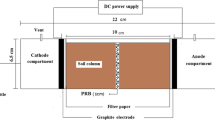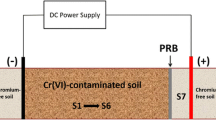Abstract
An electrokinetic–permeable reaction barrier (EK-PRB) system was introduced in this study with hydrocalumite as the barrier material. The combined system effectively remediated the Cr(VI)-contaminated clay after a 72-h treatment, and the Cr(VI) removal efficiency increased with the initial soil moisture content. Further evidence was found that the changing soil pH value and current density were highly associated with the initial moisture content, showing its important roles in the Cr(VI) removal process. Additionally, the total Cr removal efficiency was much lower than that of Cr(VI) owing to the partial conversion of Cr(VI) to Cr(III) in the electrokinetic remediation process. Under high soil moisture conditions (40 %), the removal efficiency of Cr(VI) and total Cr was 96.6 and 67.3 %, respectively. Further analysis also revealed the new mineral phase, chromate hydrocalumite, for Cr fixation in the hydrocalumite barrier, which was significantly affected by the initial soil moisture content. Our results showed that the EK-PRB system with a hydrocalumite barrier is highly promising with great potential for the effective remediation of Cr(VI)-contaminated clay and engineering implementation.







Similar content being viewed by others
References
Acar YB, Alshawabkeh AN (1993) Principles of electrokinetic remediation. Environ Sci Technol 27:2638–2647
Al-Hamdan AZ, Reddy KR (2008) Transient behavior of heavy metals in soils during electrokinetic remediation. Chemosphere 71:860–871
Birnin-Yauri UA, Glasser FP (1998) Friedel’s salt, Ca2Al(OH)6(Cl, OH)•2H2O: its solid solutions and their role in chloride binding. Cem Concr Res 28:1713–1723
Cang L, Zhou DM, Wu DY, Alshawabkeh AN (2009) Coupling electrokinetics with permeable reactive barriers of zero-valent iron for treating a chromium contaminated soil. Sep Sci Technol 44:2188–2202
Cappai G, Gioannis GD, Muntoni A, Spiga D, Zijlstra JJP (2012) Combined use of a transformed red mud reactive barrier and electrokinetics for remediation of Cr/As contaminated soil. Chemosphere 86:400–408
Dai Y, Qian G, Cao Y, Chi Y, Xu Y, Zhou J, Liu Q, Xu ZP, Qiao S (2009) Effective removal and fixation of Cr(VI) from aqueous solution with Friedel’s salt. J Hazard Mater 170:1086–1092
Fonseca B, Pazos M, Tavares T, Sanromán MA (2012) Removal of hexavalent chromium of contaminated soil by coupling electrokinetic remediation and permeable reactive biobarriers. Environ Sci Pollut Res 19:1800–1808
Goh KH, Lim TT, Dong Z (2008) Application of layered double hydroxides for removal of oxyanions: a review. Water Res 42:1343–1368
Grover K, Komarneni S, Katsuki H (2009) Uptake of arsenite by synthetic layered double hydroxides. Water Res 43:3884–3890
Grover K, Komarneni S, Katsuki H (2010) Synthetic hydrotalcite-type and hydrocalumite-type layered double hydroxides for arsenate uptake. Appl Clay Sci 48:631–637
Guo QH, Tian J (2013) Removal of fluoride and arsenate from aqueous solution by hydrocalumite via precipitation and anion exchange. Chem Eng J 231:121–131
He YT, Traina SJ (2005) Cr(VI) reduction and immobilization by magnetite under alkaline pH conditions: the role of passivation. Environ Sci Technol 39:4499–4504
James BR (2001) Remediation-by-reduction strategies for chromate-contaminated soils. Environ Geochem Health 23:175–179
Jang M, Min SH, Park JK, Tlachac EJ (2007) Hydrous ferric oxide incorporated diatomite for remediation of arsenic contaminated groundwater. Environ Sci Technol 41:3322–3328
Klausen J, Vikesland PJ, Kohn T, Burris DR, Ball WP, Roberts AL (2003) Longevity of granular iron in groundwater treatment processes: solution composition effects on reduction of organohalides and nitroaromatic compounds. Environ Sci Technol 37:1208–1218
Li Y, Wang J, Li Z, Liu Q, Liu J, Liu L, Zhang X, Yu J (2013) Ultrasound assisted synthesis of Ca-Al hydrotalcite for U (VI) and Cr (VI) adsorption. Chem Eng J 218:295–302
Ludwig RD, Su C, Lee TR, Wilkin RT, Acree SD, Ross RR, Keeley A (2007) In situ chemical reduction of Cr(VI) in groundwater using a combination of ferrous sulfate and sodium dithionite: a field investigation. Environ Sci Technol 41:5299–5305
Perkins RB, Palmer CD (2001) Solubility of chromate hydrocalumite (3CaO• Al2O3•CaCrO4•nH2O) 5-75°C. Cem Concr Res 31:983–992
Prasanna SV, Kamath PV, Shivakumara C (2007) Synthesis and characterization of layered double hydroxides (LDHs) with intercalated chromate ions. Mater Res Bull 42:1028–1039
Qian G, Feng L, Zhou J, Xu Y, Liu J, Zhang J, Xu ZP (2012) Solubility product (Ksp)-controlled removal of chromate and phosphate by hydrocalumite. Chem Eng J 181:251–258
Radha AV, Kamath PV, Shivakumara C (2005) Mechanism of the anion exchange reactions of the layered double hydroxides (LDHs) of Ca and Mg with Al. Solid State Sci 7:1180–1187
Reddy KR, Chinthamreddy S (1999) Electrokinetic remediation of heavy metal -contaminated soils under reducing environments. Waste Manag 19:269–282
Reddy KR, Chinthamreddy S (2003) Effects of initial form of chromium on electrokinetic remediation in clays. Adv Environ Res 7:353–365
Reddy KR, Parupudi US, Devulapalli SN, Xu CY (1997) Effects of soil composition on the removal of chromium by electrokinetics. J Hazard Mater 55:135–158
Reddy KR, Saichek RE, Maturi K, Ala P (2002) Effects of soil moisture and heavy metal concentrations on electrokinetic remediation. Indian Geotech J 32:258–288
Reddy KR, Xu CY, Chinthamreddy S (2001) Assessment of electrokinetic removal of heavy metals from soils by sequential extraction analysis. J Hazard Mater 84:279–296
Sanjay K, Arora A, Shekhar R, Das RP (2003) Electroremediation of Cr(VI) contaminated soils: kinetics and energy efficiency. Colloids Surf A Physicochem Eng Asp 222:253–259
Sawada A, Mori K, Tanaka S, Fukushima M, Tatsumi K (2004) Removal of Cr(VI) from contaminated soil by electrokinetic remediation. Waste Manag 24:483–490
Smith WL, Gadd GW (2000) Reduction and precipitation of chromate by mixed culture sulphate-reducing bacterial biofilms. J Appl Microbiol 88:983–991
Weng CH, Lin YT, Lin TY, Kao CM (2007) Enhancement of electrokinetic remediation of hyper-Cr(VI) contaminated clay by zero-valent iron. J Hazard Mater 149:292–302
Wu YY, Chi Y, Bai HM, Qian G (2010) Effective removal of selenate from aqueous solutions by the Friedel phase. J Hazard Mater 176:193–198
Yeung AT, Gu YY (2011) A review on techniques to enhance electrochemical remediation of contaminated soils. J Hazard Mater 195:11–29
Yuan C, Chiang TS (2007) The mechanisms of arsenic removal from soil by electrokinetic process coupled with iron permeable reaction barrier. Chemosphere 67:1533–1542
Zhang J, Xu Y, Li W, Zhou J, Zhao J, Qian G, Xu ZP (2012) Enhanced remediation of Cr(VI)-contaminated soil by incorporating a calcined-hydrotalcite-based permeable reactive barrier with electrokinetics. J Hazard Mater 239:128–134
Zhang M, Reardon EJ (2003) Removal of B, Cr, Mo, and Se from Wastewater by Incorporation into Hydrocalumite and Ettringite. Environ Sci Technol 37:2947–2952
Acknowledgments
This project is financially supported by the National Natural Science Foundation of China (No. 21107067) and Innovative Research Team in University (No. IRT13078).
Author information
Authors and Affiliations
Corresponding author
Additional information
Responsible editor: Philippe Garrigues
Rights and permissions
About this article
Cite this article
Xu, Y., Xu, X., Hou, H. et al. Moisture content-affected electrokinetic remediation of Cr(VI)-contaminated clay by a hydrocalumite barrier. Environ Sci Pollut Res 23, 6517–6523 (2016). https://doi.org/10.1007/s11356-015-5685-y
Received:
Accepted:
Published:
Issue Date:
DOI: https://doi.org/10.1007/s11356-015-5685-y




